In modern restorative dentistry, zirconia dental bridges have become a preferred solution for patients who need to replace missing teeth. Made from zirconium dioxide, a strong and biocompatible ceramic, these bridges combine durability with natural-looking aesthetics. They are widely used to restore both front and back teeth, offering patients comfort, functionality, and confidence in their smile.

A zirconia dental bridge is a fixed prosthesis crafted from zirconium dioxide, a ceramic material recognized for its strength and tissue-friendly properties. Zirconia not only blends seamlessly with surrounding natural teeth but also avoids issues associated with metal-based bridges, such as gray lines at the gum or allergic reactions.
Originally applied in orthopedic medicine for joint replacements, zirconia was later adopted in dentistry in the early 2000s. With the development of CAD/CAM technology, zirconia bridges can now be designed and fabricated with high precision, providing a customized fit tailored to each patient’s dental structure.
Strength and Longevity
Zirconia offers excellent resistance to fracture and wear, making it suitable even for patients with strong bite forces or mild bruxism. Its resilience ensures long-lasting results in both anterior and posterior restorations.
Aesthetic Qualities
Thanks to its translucency and ability to be shade-matched, zirconia delivers a natural look that integrates beautifully with adjacent teeth. This is especially valuable for visible front teeth restorations.
Biocompatibility
As a metal-free material, zirconia is highly biocompatible, minimizing risks of allergic reactions or gum irritation. It also helps maintain healthy surrounding tissue, making it a safe option for long-term use.
Role of CAD/CAM Technology
Digital design and manufacturing allow for accuracy and efficiency in producing zirconia bridges. CAD software enables the creation of a 3D model based on the patient’s scans, and CAM machines mill the bridge from a zirconia disc.
Step-by-Step Process
Digital impression – An intraoral scanner captures the patient’s dental structure.
Design – A 3D model of the bridge is created and fine-tuned.
Milling – The design is milled from a pre-sintered zirconia block.
Sintering – The milled bridge is fired at high temperatures to achieve full strength.
Finishing – The surface is polished and, if required, stained for color matching.
Placement – The bridge is tested in the mouth, adjusted if needed, and cemented in place.
Where Zirconia Bridges Work Best
Replacing a single missing tooth, particularly in visible areas.
Restoring several adjacent missing teeth.
Posterior restorations requiring high strength.
Patients with sensitivity or allergies to metals.
When to Consider Alternatives
Severe bruxism cases may cause wear over time.
Insufficient tooth support for anchoring the bridge.
Poor oral hygiene, which increases risk of complications.
Daily Maintenance
Brush twice daily with a soft brush and non-abrasive toothpaste.
Floss or use interdental brushes to clean under and around the bridge.
Use antibacterial mouthwash to reduce plaque buildup.
Professional Checkups
Routine cleanings help prevent gum issues.
Dentists check for wear, damage, or fit adjustments.
Lifestyle Habits
Avoid chewing very hard foods like ice or nuts.
Refrain from habits such as nail-biting or using teeth as tools.
Versus Metal-Ceramic Bridges
Aesthetics: Zirconia provides a more natural, lifelike appearance.
Durability: Both are strong, but zirconia resists fractures better.
Biocompatibility: Zirconia avoids issues linked to metal sensitivity.
Versus All-Ceramic Bridges
Aesthetics: Both offer excellent appearance; zirconia excels in back teeth where strength matters.
Strength: Zirconia surpasses other ceramics in resisting bite pressure.
Cost: Zirconia bridges may cost more initially but often outlast alternatives.
What is the typical cost of a zirconia bridge?
Prices vary depending on the number of units, case complexity, and clinic location. While zirconia is generally more expensive than traditional metal-ceramic bridges, its durability and aesthetics often justify the investment.
Is the procedure painful?
The procedure is performed under local anesthesia. Most patients feel only minor sensitivity afterward, which usually resolves within days.
How long do zirconia bridges last?
With good oral care and regular checkups, zirconia bridges can last many years, offering both stability and a natural look.
Are there any potential downsides?
Small adjustments may be needed after placement.
Zirconia’s hardness can sometimes affect opposing teeth if the bite is uneven.
Some patients may notice temporary sensitivity after fitting.